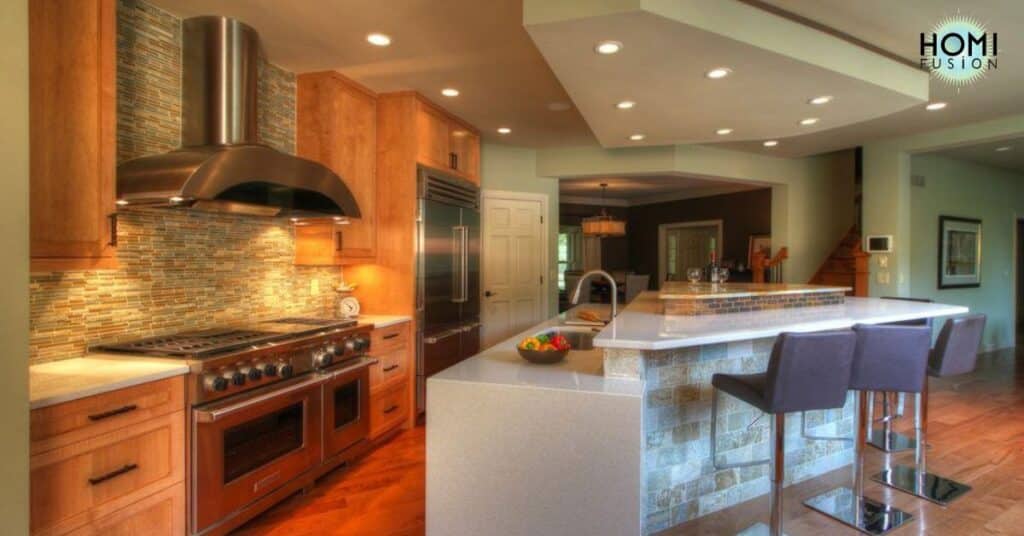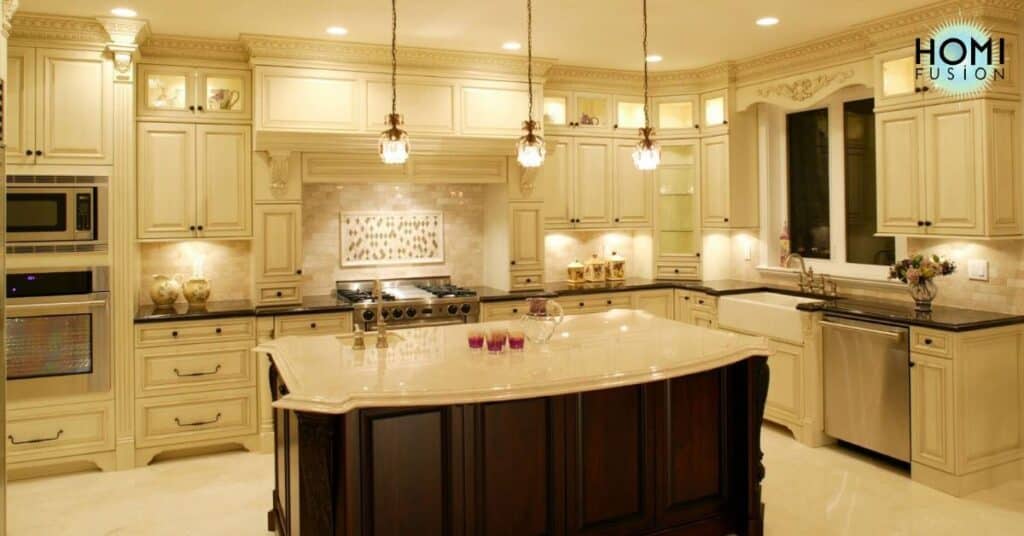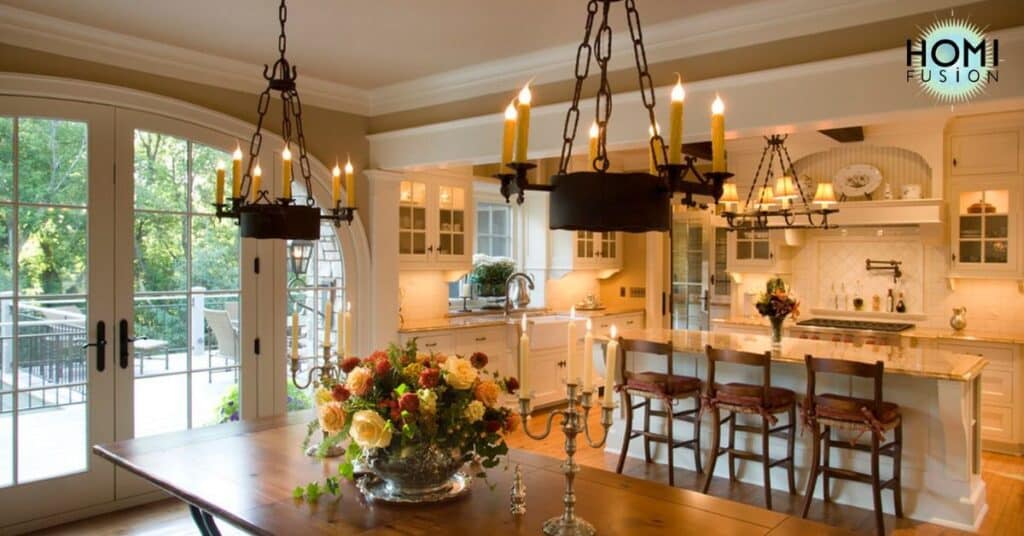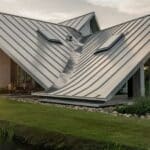Pairing kitchen and dining lights is crucial for a harmonious living space, especially in open-concept layouts. Define your home’s style—modern, traditional, rustic, or eclectic—then choose fixtures that match this theme. Coordinate shapes, finishes, and sizes for a unified look that enhances both the visual appeal and functionality of your home.
Once you have a style direction, coordinate the shapes, finishes, and sizes of your lighting fixtures for a cohesive yet distinct look. Matching pendant lights above the kitchen island with a complementary chandelier or pendants above the dining table ties the spaces together effectively, enhancing both the visual appeal and functionality of your home’s lighting design.
Kitchens Go Glam
Modern kitchens are embracing glamour with sophisticated lighting choices and luxurious finishes. Think crystal chandeliers above islands or dining areas, creating a focal point that exudes elegance and style. Glamorous kitchens often feature metallic accents, such as gold or silver hardware, paired with sleek cabinetry and statement lighting fixtures.
To achieve a glam look in your kitchen, mix textures like marble countertops with glossy cabinets and shimmering backsplashes. Consider adding mirrored surfaces or reflective tiles to enhance light and create a sense of spaciousness. The key is to balance opulence with functionality, creating a space where luxury meets everyday practicality for a truly glamorous kitchen ambiance.
Also take a look at: HOW TO PAINT OAK KITCHEN CABINETS
Bring Sparkle to Cabinetry
To bring sparkle to your cabinetry, consider installing LED strip lights or puck lights inside glass-fronted cabinets. These lights illuminate the interior, making your glassware and dishes gleam and adding a touch of elegance to your kitchen. LED tape lights are versatile and can be easily concealed, providing a seamless and polished look.

Another way to bring sparkle is by using decorative knobs or handles that catch the light and reflect it beautifully. Opt for metallic finishes like polished chrome or brass to enhance the overall sparkle of your cabinetry. By incorporating these elements, you can transform ordinary cabinets into standout features that enhance the visual appeal of your kitchen.
Consider the Style of Both Areas
When selecting lighting for your kitchen and dining areas, it’s essential to consider the overall style of your home. Determine whether your home exudes a modern, traditional, rustic, or eclectic vibe. This style direction will guide your choice of lighting fixtures. For instance:
Modern Style: Opt for sleek and minimalist lighting such as track or recessed lights for a contemporary feel.
Traditional Style: Choose elegant chandeliers or pendant lights with classic designs to complement a traditional setting.
Rustic Style: Embrace the warmth of farmhouse or industrial-style lighting fixtures like pendant lights with wooden or metal elements.
Eclectic Style: Mix and match different lighting styles to create a unique, eclectic look that reflects your personal taste.
Also take a look at: HOW LONG DO KITCHEN CABINETS LAST
Look at Fixture Shapes
The shapes of your lighting fixtures play a significant role in defining the ambiance of your kitchen and dining spaces. Here are some considerations:
Dome or Bell Shapes: These provide a classic and timeless look, suitable for both traditional and modern settings.
Linear or Geometric Shapes: Ideal for contemporary spaces, offering a clean and structured appearance.
Spherical or Globe Shapes: Add a touch of sophistication and visual interest, suitable for various styles.
Lantern or Cage Shapes: Bring a rustic or industrial charm, perfect for farmhouse or eclectic interiors.
Choosing complementary shapes can create visual harmony and balance within the combined kitchen and dining areas. Ensure the shapes align with your overall design vision.
Compare Colors and Textures

When pairing kitchen and dining lights, consider the colors and textures of the fixtures to achieve a cohesive look:
Matching Finishes: Choose fixtures with similar metal finishes (e.g., brass, matte black, chrome) to create unity.
Coordinated Textures: Opt for fixtures with similar textures (e.g., smooth, matte, brushed) for a seamless blend.
Color Coordination: Introduce shared colors between kitchen and dining lights, such as incorporating brass accents or black finishes for consistency.
Material Consistency: Ensure materials like wood, glass, or metal complement each other across both areas.
By comparing colors and textures, you can achieve a cohesive and visually pleasing lighting scheme that ties your kitchen and dining spaces together.
Don’t Overlook Functionality
While aesthetics are important, functionality should not be overlooked when selecting kitchen and dining lights:
Task Lighting: Ensure adequate brightness for tasks like cooking and dining.
Ambient Lighting: Create a comfortable ambiance for dining and socializing.
Dimmer Options: Consider fixtures with dimmer switches to adjust lighting levels based on different activities and moods.
Ceiling Height Considerations: Choose fixtures that suit the height of your ceilings to optimize both illumination and space aesthetics.
Prioritizing functionality alongside aesthetics will result in a well-rounded lighting design that enhances the usability and enjoyment of your kitchen and dining areas.
Our secrets for mixing and matching lighting in one space
In interior design, effectively mixing and matching lighting can transform a space, adding depth and character. Here are some key secrets to achieving a harmonious and stylish blend of lighting fixtures within one room.

Find a common thread
Coordinate Finishes: Choose lighting fixtures with similar finishes (e.g., brushed nickel, matte black) to create cohesion.
Match Styles: Maintain consistency in style—whether modern, industrial, or traditional—to tie the room together.
Consistent Shapes: Opt for lighting fixtures that share similar shapes or forms for a unified aesthetic.
Balance scale
Create a Focal Point: Use one standout, large-scale fixture (e.g., chandelier) as a focal point and complement it with smaller, pared-down pieces.
Consider Proportions: Ensure that the scale of lighting fixtures complements the size of the room without overwhelming the space.
Visual Hierarchy: Balance visual weight by mixing larger and smaller fixtures strategically.
Layer for dimension
Introduce Variety: Incorporate different types of lighting—such as overhead, task, and accent lighting—to add depth and texture.
Highlight Vignettes: Use specific lighting types like wall sconces or picture lights to illuminate focal points or decorative displays.
Play with Placement: Experiment with floor lamps, table lamps, and pendant lights at different heights to create layers of light.
Don’t be afraid of contrast
Mix Styles and Finishes: Embrace contrasting styles, finishes, and shapes to add visual interest and personality.
Experiment Creatively: Combine modern and vintage elements or bold and subtle finishes for a unique and dynamic look.
Trust Your Instincts: Explore diverse combinations of lighting fixtures, and don’t hesitate to step outside traditional design boundaries.
Learn How to Pair Kitchen and Dining Lights
Creating a cohesive lighting design for your kitchen and dining areas is essential for a well-balanced and functional living space. Start by identifying the overall style you want to achieve, whether it’s modern, traditional, rustic, or eclectic. Choose lighting fixtures that align with this aesthetic to maintain consistency throughout the space.

Coordinate the shapes, finishes, and sizes of the fixtures to create a unified look while allowing each area to retain its unique personality. For instance, pairing matching pendant lights above the kitchen island with a complementary chandelier or pendants above the dining table can effectively tie the spaces together.
Best Kitchen Cabinets Lighting Tips and Tricks
Choose under-cabinet LED strips or puck lights for functional and ambient kitchen lighting. Match the lighting color temperature to your kitchen’s color scheme—warm tones for coziness, cool tones for freshness. Add decorative sconces or mini pendant lights to enhance cabinetry aesthetics and personalize your kitchen space.
Functional Sculpture
Illuminate your kitchen cabinets with lighting that not only serves a functional purpose but also enhances the overall aesthetic. Consider under-cabinet LED strips or puck lights to provide task lighting for countertop activities while adding a subtle ambiance to the space.
Color Matters
Choose lighting for your kitchen cabinets that complements the color scheme of your kitchen. Warm-toned lights create a cozy atmosphere, while cooler tones can make the space feel bright and fresh.
Style Accents
Incorporate lighting fixtures that act as stylish accents for your kitchen cabinets. For example, decorative sconces or mini pendant lights can add visual interest and personality to the cabinetry area.
Not all Work
Not all lighting fixtures need to serve a purely functional purpose. Consider integrating decorative pendant lights or chandeliers into your kitchen and dining areas to elevate the ambiance and aesthetic appeal.
Adjustable Pendants
Opt for adjustable pendant lights that allow you to customize the lighting direction and intensity based on your needs. This flexibility is particularly useful in multifunctional spaces like kitchens.
Surface Consideration
When choosing lighting fixtures, consider the surfaces they will illuminate. Different light sources can affect the appearance of countertops, backsplashes, and cabinet finishes, so select fixtures that enhance these elements.
Fluorescent Under-Cabinet Lighting

Explore the benefits of fluorescent under-cabinet lighting for illuminating workspaces efficiently. Fluorescent lights provide bright, uniform lighting that is ideal for tasks such as food preparation and cooking.
Cabinet Accent Lights
Cabinet accent lights are a stylish and functional addition to any kitchen. These discreet lighting fixtures are designed to highlight the architectural details and contents of your cabinets, adding depth and ambiance to the space. By strategically placing accent lights inside cabinets or along the edges, you can create a warm and inviting atmosphere while making it easier to find and display items stored within.
Incorporating cabinet accent lights can also enhance the overall aesthetic of your kitchen, especially when paired with under-cabinet task lighting. Whether you’re showcasing decorative dinnerware, glassware, or collectibles, these lights provide a subtle yet impactful way to elevate the look of your cabinetry, making your kitchen feel more luxurious and well-designed.
Frequently asked questions
How do you pair kitchen and dining lights?
Pairing kitchen and dining lights involves choosing fixtures with similar styles and finishes to create a cohesive look. Coordinate the placement of lights to balance functionality and aesthetic appeal in both areas.
Should dining room and kitchen lights match?
Matching kitchen and dining room lights isn’t necessary, but coordinating styles or finishes can create a cohesive look. Consider similar colors and shapes for visual harmony.
What lights look best in a kitchen?
The best lights for a kitchen include recessed lighting for overall illumination, pendant lights for islands, and under-cabinet lighting for task areas. Opt for warm white LEDs for a cozy ambiance.
How do you coordinate kitchen lights?
Coordinate kitchen lights by mixing overhead, task, and accent lighting for layers of brightness. Use similar finishes and styles for a cohesive design.
Final words
Pairing kitchen and dining lights is essential for creating a cohesive and inviting living space. By following key principles, such as coordinating styles, choosing complementary fixtures, and balancing functionality with aesthetics, you can achieve a harmonious lighting design. Select lighting fixtures that share similar finishes, shapes, or colors to create visual continuity between the kitchen and dining areas.
Consider layering different types of lighting, such as overhead, task, and accent lights, to accommodate various activities and enhance the overall ambiance. Additionally, ensure proper placement of fixtures to provide adequate illumination while maintaining an appealing balance in the room. By paying attention to these details and focusing on creating a cohesive look, you can transform your kitchen and dining areas into stylish and functional spaces that reflect your personal taste and lifestyle.

Meet Emily, a seasoned professional with 5 years of expertise in the field of home design. Her passion and extensive experience bring a unique perspective to our website, enriching your journey with insightful content.







